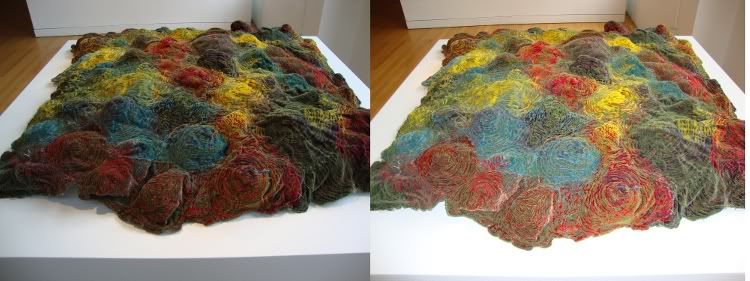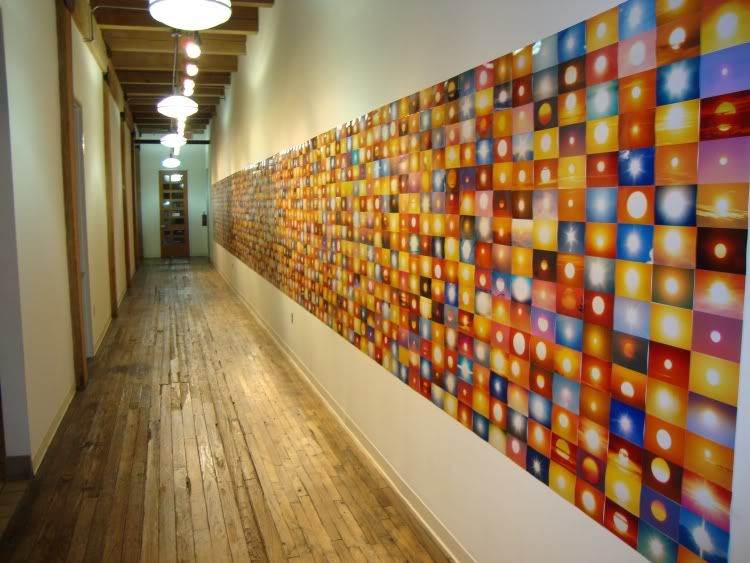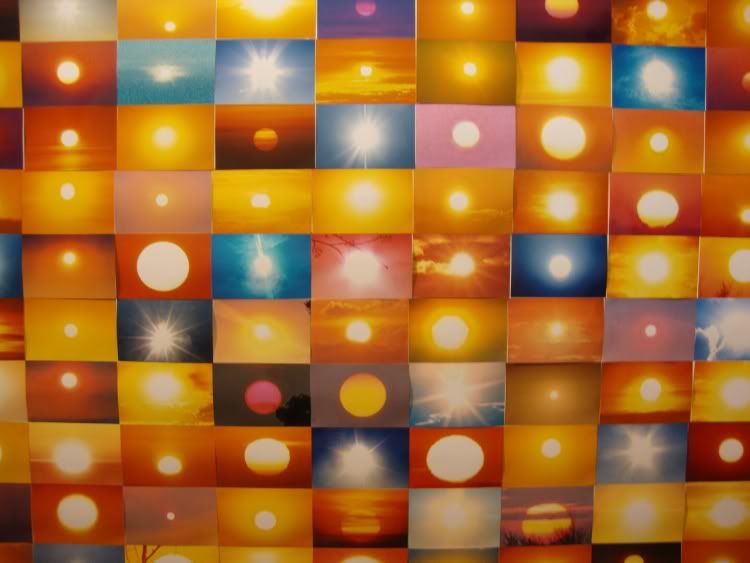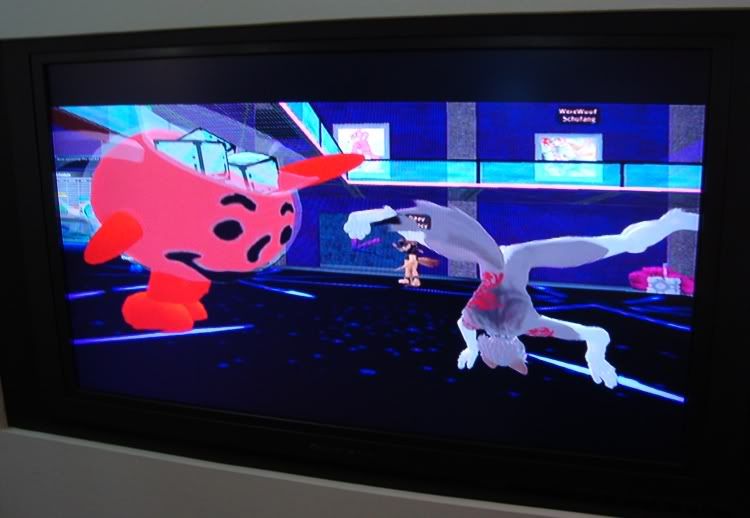The exception is Kia Neill (who did "Stampede" at Box 13), and she manages to avoid the incoherence of the rest of the show by having work that necessarily has be separated from the other work. She is the only sculptor in the show, and in this show works with pieces of velvet. So they are laid flat on little plinths, instead of jumbled together on the walls with the other art.
The work was in this over-bright exhibition space, but I noticed when I took a flash photo of one of the pieces how different it would look under different light. The velvet really catches light.

Kia Niell, Untitled (Multicolored Velvet), velvet, thread, polyester fibers, left--ambient light, right--flash photo
I know it looks like the flash is just washing out the colors, but what is actually happening here is that the little ridges in the piece are catching light that in the un-flashed photo are in shadow. The point I'm making is that you could get startling effects with this piece by putting spotlights on it from different angles. I assume that's intentional, but even if it's not, I like it. (Of course I really just wanted to rub my hands on this piece, but as a good citizen, I restrained myself.)
After I left Space125, I went over to FotoFest. I didn't have high hopes for Poke because of the theme--social media. First of all, most "media" art in galleries kind of bores me. A gallery is just not a good place to watch a video, for example. (Obvious exceptions would be pieces by Tony Oursler or Nam June Paik, whose work is simultaneously sculpture and video.) Second, an art show about social media just sounds like an attempt for a gallery to latch itself onto the latest cool thing. So no expectations going in.
Was I wrong--this show was great fun. The art is likely to have a shelf-life of five minutes, but for those five minutes, I loved it. You walk in and projected on the wall is a grid of hundreds of first person YouTube statements. Of course it is a cacophony of "information"--literally like watching a thousand YouTube videos of people speaking to the camera all at once. But it was so cool to look at. This piece was by Christopher Baker, but in a way, it was also by his many, many unwitting collaborators. And really, it's the unwitting collaborators that make these pieces so fun.

Penelope Umbrico, Suns from the Internet, 2008-2009
Penelope Umbrico's "Suns from the Internet" couldn't exist without unwitting collaborators. What Umbrico did here was to type the word "sun" into Flickr's search engine, download the many (thousands!) of photos of sunsets, sunrises, sunny skies, etc., crop them so just the sun is showing, print them out and make this utterly fantastic mosaic.

Penelope Umbrico, Suns from the Internet detail, 2008-2009
Aside from looking great, it made me think about how important the sun is to us humans. Not just in the obvious way that we wouldn't exist without it (indeed, the existence of life and civilization on this planet can be seen as an accidental result of the birth of this particular star), but that we all have a kind of personal relationship with it. Not too many of us worship it as a god these days, but we still pay technological tribute to it as if we did.
Jon Rafman's piece "Kool-Aid Man iSecond Life" hardly even seems like a work of art. It's more along the lines of a collection of prank calls. I don't mean to put it down, because really it's hugely entertaining. What he did was somehow create a Kool-Aid man avatar for himself, and then went into Second Life to see what kind of weird or cool stuff he could encounter--interesting avatars, weird landscapes, violence, sex, furries, etc.

Jon Rafman, Kool-Aid Man iSecond Life detail, digital video, 2009
(Let's see if PhotoBucket lets me keep that image up.)

Jon Rafman, Kool-Aid Man iSecond Life detail, digital video, 2009
So Rafman is sort of being a tourist in other people's weirdness. And that is awesome -- crash-through-a-brick-wall awesome.
There were other pieces in the show I liked--but you should get yourself downtown and check them out yourself. I have to admit that some of them looked like they might be interactive, but I couldn't figure out how to interact. Whatever. I liked enough of this show to recommend it without reservations.




GAWD I loved this review again!
ReplyDelete